This mode enables you to send PDF files with a digital signature.
The following digital signatures can be used on this machine.
This mode uses the device signature certificate and key pair inside the machine to add a digital signature to the file, which enables the recipient to verify which device scanned it. The recipient can verify the device that signed the file, and whether the file has been changed after it was signed.
This mode uses information about the user currently logged in to the machine using an SSO-H login service and the user signature certificate and key pair inside the machine to add a digital signature to the file, which enables the recipient to verify which user signed it. The recipient can verify the user that signed the file, and whether the file has been changed after it was signed.
This mode displays a visible signature on the PDF when it is viewed, which enables the recipient to easily see that the file has a digital signature. You can also check the detailed signature information from the Properties of the signature. In addition, you can decide the position of the visible signature displayed on the PDF file.
|
IMPORTANT
|
|
You cannot add a digital signature if the following settings are already specified:
If [Optimize PDF for Web] in Function Settings (Settings/Registration) is set to 'On' and 'Reader Extensions' is set as the file format (See "Optimize PDF for Web.")
For information on the modes which cannot be set in combination with this mode, see "Unavailable Combination of Functions."
|
|
NOTE
|
|
If you select to add both a device signature and user signature, the device signature is added before the user signature.
If a PDF file that has multiple signatures added to it is verified using software such as Adobe Reader/Adobe Acrobat, only the last signature added to the file is valid. The other signatures cause the file to be handled as if it has been altered by adding another signature.
If you change the file format to a format other than 'PDF' after setting to add a digital signature, a message confirming whether you want to change the file format is displayed. If you change the file format, the digital signatures you have set to add are cancelled.
For information on validating certificates, registering certificates in the trusted certificates list, and verifying signatures on the recipient side, see the documentation for the software that supports the PDF format (such as Adobe Reader/Adobe Acrobat).
As an example, the procedure for scanning an original and storing it in the Advanced Space is explained in this section.
|
For information on the optional products required to use this function, see "Optional Products Required for Each Function."
|
NOTE
|
|
To store the PDF file with the device signature, you must first create the certificate and key pair for the device signature. (See "Setting a Key Pair and Device Certificate.")
The [Cert. Thumbprint (SHA1)] information that can be checked on the machine contains sender information used by the recipient of a PDF file to validate the reliability of the device signature by matching it with the MD5 or SHA-1 message digest number. (See "Confirming the Device Signature Certificate.")
If the SSO-H login service is set and an e-mail address is registered for the user, in addition to adding the device signature, the Author property of the PDF file is set to the e-mail address of the user.
|
1.
Select the desired space and folder.
2.
Place your originals → press [Scan] → [File Format].
3.
Select [PDF] → press [Set Details].
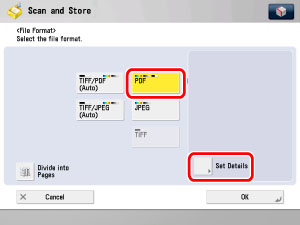
4.
Press [Add Digital Signatures].
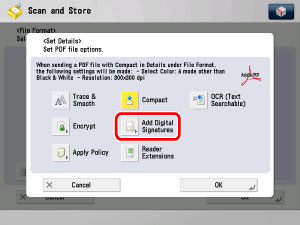
5.
Press [Device Signature] → [OK].
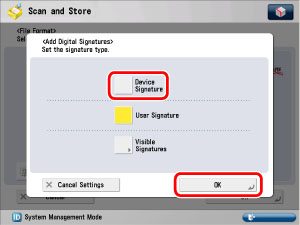
6.
Press [OK] → [OK].
7.
Press  .
.
 .
.You can add a user signature using information about the user currently logged in to the machine using a login service and the user signature certificate and private key inside the machine.
For information on the optional products required to use this function, see "Optional Products Required for Each Function."
|
NOTE
|
|
The following conditions are necessary to add a user signature to a PDF or file:
SSO-H login service must be set for the machine.
A user certificate must be installed in the machine using the Remote UI. (See "Installing/Checking/Erasing a User Signature Certificate and Key Pair.")
For information on the certificate authority that issues the User Certificate for each user compatible with this machine, see the notice included with the optional equipment.
|
1.
Select the desired space and folder.
For more information on the SSO-H login service, see "Using a Login Service."
2.
Place your originals → press [Scan] → [File Format].
3.
Select [PDF] → press [Set Details].
4.
Press [Add Digital Signatures].
5.
Press [User Signature] → press [OK].
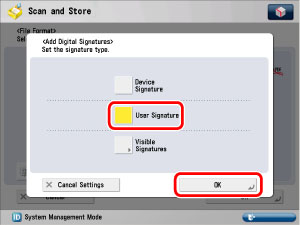
6.
Press [OK] → [OK].
7.
Press  .
.
 .
.You can select the position for the visible signature.
|
NOTE
|
|
You can specify the settings for Visible Signature only when device signature or user signature is set for the PDF.
You can not set the Visible Signature if the following setting is already set.
If [Format PDF to PDF/A] in Function Settings (Settings/Registration) is set to 'On' (See "Standardize PDF as PDF/A.")
|
1.
Select the desired space and folder.
2.
Place your originals → press [Scan] → [File Format].
3.
Select [PDF] → press [Set Details].
4.
Press [Add Digital Signatures].
5.
Press [Visible Signatures].

6.
Select the position for the signature → press [OK].
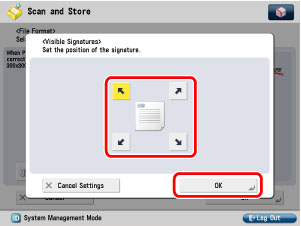
If [Cancel] is pressed, the setting is cancelled and the screen returns to the previous screen.
7.
Press [OK] → [OK] → [OK].
8.
Press  .
.
 .
.